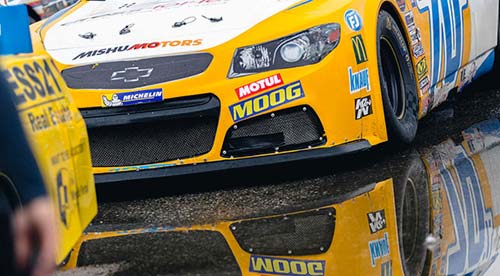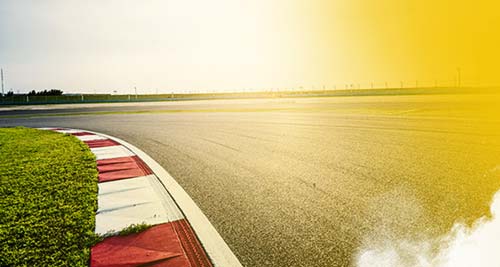Simply put, bump steer is when your wheels steer themselves without any input from you (the driver) or the steering wheel.
How is that possible? Easy: driving over bumps in the road can push your wheels up, causing them to change direction. Excessive bump steer can increase tyre wear and tear and make it more difficult to control your car on rough roads. What's the connection between bump steer and NASCAR®? In every corner of the race track there is a curb stone, which is slightly raised from the tarmac to create a bump that affects steering. When driving the ideal line, a race car will take the curb stone in every corner, making bump steer an important element to consider.
Bump steer and your car
It is impossible to eliminate bump steer completely. Instead, the front suspension and steering links on most modern cars are designed to significantly reduce its impact. This means that if you (or your mechanic) do any work on your suspension, you should ensure that everything is carefully bolted, the specifically calculated pivot points are all correct and your wheels are aligned as recommended in your owners’ manual, otherwise unwanted bump steer could be created.
Additionally, it is important to use the right parts and the right sizes. For example, the tie rod needs to travel on the same arc as the suspension when the car is in motion. To do this, and minimise bump steer, it is essential to match lengths and arcs.
What this means in practice is the centreline of the outer tie rod needs to line up with the centreline of the lower ball joint, plus the inter tie rod needs to line up with the lower pivot point. This will ensure the length and angle of the tie rod and suspension are the same, minimising bump steer. If you are in any doubt about bump steer and wheel alignment, talk to a certified mechanic.
Measuring bump steer on a NASCAR® race car
Bump steer is usually measured in degrees of steer per meter of upwards motion or degrees per foot. Typical values range from two to ten degrees per metre for the front wheels.
To measure the bump steer on a race car, a quality bump steer gauge is used. A single dial gauge is easier to use as all the information is available in a single glance. A gauge with two dials sometimes needs two people to keep an eye on the indicators, especially if the bump is out of adjustment.
Before measurements are taken, the race car is prepared: the front suspension is complete; all components are tight and in the correct position; and the suspension is set for the expected race track conditions.
A race car aims to run .005 to .015 thousands of bump out, and never allows the tyres to bump in. This is because bump out can make the car more stable on corners, while bump in can be unpredictable. If necessary, small adjustments (i.e. a few millimetres at a time) are made.
NASCAR® Insiders
Continue the journey with NASCAR® Insiders.
Discover the world of NASCAR® Insiders and get the inside track to exclusive behind the scenes content, exciting interviews with NASCAR® legends and visionaries and so much more. Read more here.


